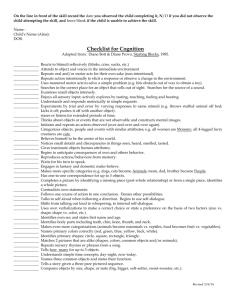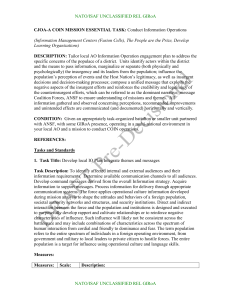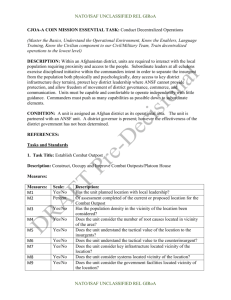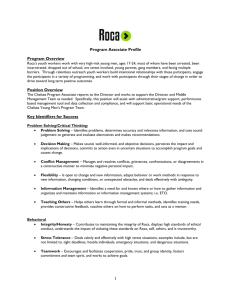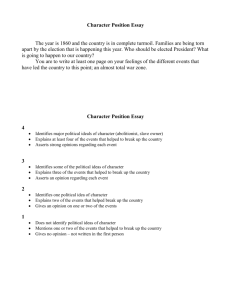CJOA_A COIN Task 8 Understand the Operational Environment
advertisement
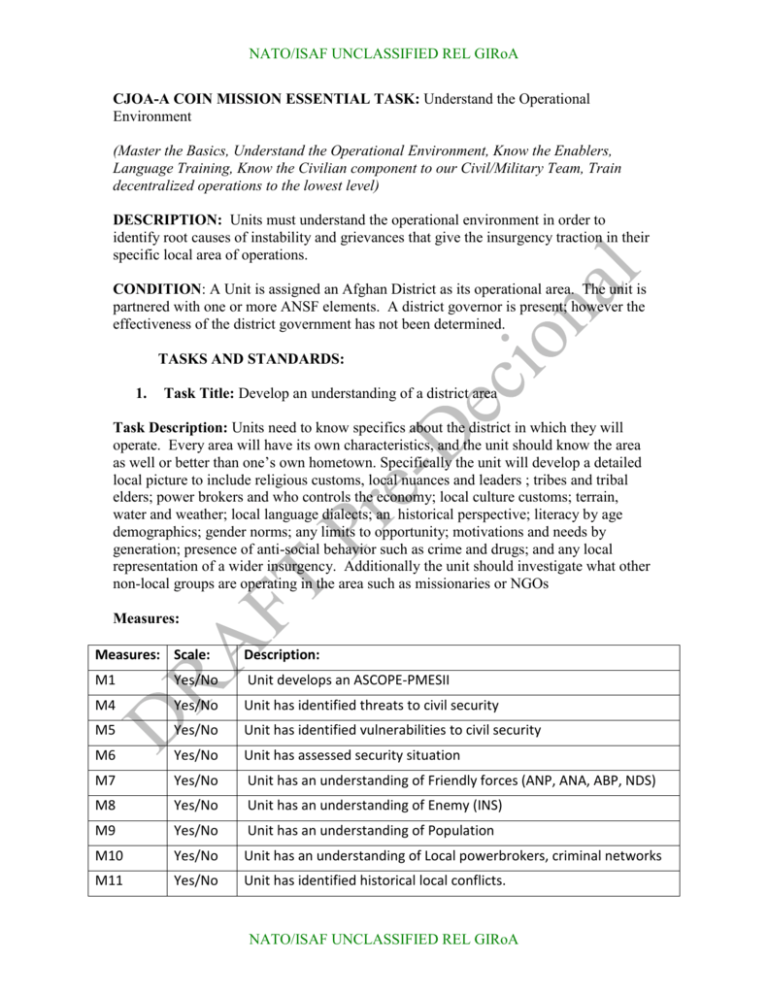
NATO/ISAF UNCLASSIFIED REL GIRoA CJOA-A COIN MISSION ESSENTIAL TASK: Understand the Operational Environment (Master the Basics, Understand the Operational Environment, Know the Enablers, Language Training, Know the Civilian component to our Civil/Military Team, Train decentralized operations to the lowest level) DESCRIPTION: Units must understand the operational environment in order to identify root causes of instability and grievances that give the insurgency traction in their specific local area of operations. CONDITION: A Unit is assigned an Afghan District as its operational area. The unit is partnered with one or more ANSF elements. A district governor is present; however the effectiveness of the district government has not been determined. TASKS AND STANDARDS: 1. Task Title: Develop an understanding of a district area Task Description: Units need to know specifics about the district in which they will operate. Every area will have its own characteristics, and the unit should know the area as well or better than one’s own hometown. Specifically the unit will develop a detailed local picture to include religious customs, local nuances and leaders ; tribes and tribal elders; power brokers and who controls the economy; local culture customs; terrain, water and weather; local language dialects; an historical perspective; literacy by age demographics; gender norms; any limits to opportunity; motivations and needs by generation; presence of anti-social behavior such as crime and drugs; and any local representation of a wider insurgency. Additionally the unit should investigate what other non-local groups are operating in the area such as missionaries or NGOs Measures: Measures: Scale: Description: M1 Yes/No Unit develops an ASCOPE-PMESII M4 Yes/No Unit has identified threats to civil security M5 Yes/No Unit has identified vulnerabilities to civil security M6 Yes/No Unit has assessed security situation M7 Yes/No Unit has an understanding of Friendly forces (ANP, ANA, ABP, NDS) M8 Yes/No Unit has an understanding of Enemy (INS) M9 Yes/No Unit has an understanding of Population M10 Yes/No Unit has an understanding of Local powerbrokers, criminal networks M11 Yes/No Unit has identified historical local conflicts. NATO/ISAF UNCLASSIFIED REL GIRoA NATO/ISAF UNCLASSIFIED REL GIRoA M13 Yes/No M14 Yes/No M15 Yes/No M16 Yes/No M17 Yes/No Unit understands the Freedom of Movement in the District pertaining to Lines of Communications Unit understands the Freedom of Movement in the District pertaining to the Import of economic goods Unit understands the Freedom of Movement in the District pertaining to Export of economic goods Unit understands the Freedom of Movement in the District pertaining to Governance Unit understands the Freedom of Movement in the District pertaining to the Population within the district 2. Task Title: Civil Control Task Description: The unit needs to understand what resources are available to assist in civil control. Identify any formal local security forces, and informal groups such as local groups, tribes, militias, or local volunteer security groups. Examine and assess the layout of buildings, roads, constricted areas and choke points. Develop a plan for potential isolation of sections, checkpoints, patrolling routes, and major transporation route roadblocks. Be prepared to initiate measures to reinstitute and maintain civil control. Measures: Measures: Scale: Description: M1 Yes/No Unit identifies the process for dispute resolution within a village, village cluster, and District M2 Yes/No Unit identifies any Shadow Government influence on dispute resolution within a village, village cluster, and District M3 Yes/No Identify shortcomings in local dispute resolution process that are being exploited by Shadow Government dispute resolution process M4 Yes/No M5 Yes/No Unit identifies formal, GIRoA, and informal, tribal and cultural influence on dispute resolution within a village, village cluster, to include and District to include Mullahs, Maliks, Mirabs, and key elders, Unit identifies secure locations to facilitate Rule of Law M6 Yes/No Unit identifies any possible inter-tribal peace agreements on nonviolence NATO/ISAF UNCLASSIFIED REL GIRoA NATO/ISAF UNCLASSIFIED REL GIRoA M7 Yes/No Unit identifies local traditional tribal security forces, i.e. arbakai and lashghar and their boundaries M8 Yes/No Unit understands non-lethal crowd control techniques place holder. M9 Yes/No Unit identifies the process for dispute resolution within a village, village cluster, and District M10 Yes/No Unit identifies any Shadow Government influence on dispute resolution within a village, village cluster, and District M11 Yes/No Identify shortcomings in local dispute resolution process that are being exploited by Shadow Government dispute resolution process M12 Yes/No M13 Yes/No Unit identifies formal, GIRoA, and informal, tribal and cultural influence on dispute resolution within a village, village cluster, to include and District to include Mullahs, Maliks, Mirabs, and key elders, Unit identifies secure locations to facilitate Rule of Law M14 Yes/No Unit identifies any possible inter-tribal peace agreements on nonviolence M15 Yes/No Unit identifies local traditional tribal security forces, i.e. arbakai and lashghar and their boundaries M16 Yes/No Unit understands non-lethal crowd control techniques place holder. 3. Task Title: Governance Task Description: Every area has its own formal or informal form of local government. This must be completely understood in terms of how rules are established and amended, how rules are enforced, how local grievances or adjudicated, how economic fairness is maintained, and how those will disobey are treated. The next governance item the unit needs to asses is the formal structure and interaction with higher levels of government. The unit should understand how involved a higher level of government is and how it manages legitimacy. How are local taxes, tolls, and needs assed and collected as well as how are taxes collected by the higher government? What services are provided by local and higher levels of government? This task should focus on the processes and defined agreements rather than on personalities. Measures: NATO/ISAF UNCLASSIFIED REL GIRoA NATO/ISAF UNCLASSIFIED REL GIRoA Measures: Scale: Description: M1 Yes/No Unit understands the tribal dispositions (mantaqa) within the district M2 Yes/No Unit identifies tribal boundaries that straddle adjacent district borders M3 Yes/No Unit understands tribal compositions in each village M4 Yes/No Unit understands existing system of government mechanics M5 Yes/No Unit understands the District Center Tashkil (authorized manning document) M6 Yes/No Unit understands responsibilities of the line ministers at the district level M7 Yes/No Unit understands the District Delivery Program (DDP)move to stability task M8 Yes/No Unit understands Afghan Government funding streams and pay issues M9 Yes/No Unit identifies Non-Governmental Organizations (NGO) and International Government Organizations (IGO) working in the district M10 Yes/No Unit identifies missions of NGOs/IGOs M11 Yes/No Unit identifies capabilities of NGOs/IGOs 4. Task Title: Afghan National Security Force Task Description: In the unit’s assigned area there is probably a national security force or national police unit which owns the local area. The unit should know in detail which units are assigned to operate in the area, and if any ANSF units are physically located in our unit’s area. The unit should understand the command and control, the readiness, the composition, the personalities, training readiness, the logistical efficiency and the rotational basis of the ANSF unit. Measures: NATO/ISAF UNCLASSIFIED REL GIRoA NATO/ISAF UNCLASSIFIED REL GIRoA 5. Measures: Scale: Description: M1 Yes/No M2 Yes/No M3 Yes/No Unit identifies the composition of the ANSF units in the district (ANA, ANP, ABP, ANCOP, APPF, VSP) Unit identifies the disposition of the ANSF units in the district (ANA, ANP, ABP, ANCOP, APPF, VSP) Unit identifies Tashkil of ANSF units (ANA, ANP, ABP, ANCOP, APPF, VSP) M4 Yes/No Unit identifies the level of training of the ANSF elements M5 Yes/No Unit understands differences in the Rules of Engagement for each ANSF element (ANA, ANP, ABP, ANCOP, APPF, VSP) Task Title: Essential Services Task Description: The definition and composition of essential services varies as well as the responsibility of who supplies these essential services. In some parts of America essential services may be viewed as potable water, sewage treatment, power, trash collection, phone service, and public roads. Other areas of America include internet access, media outlets, public education, healthcare, and light rail transportation. In Afghanistan the description of what are essential services will be different. Generally all people need water access, and a process to treat sewage and collect trash. Electricity and phone, or cell, service are important enough in a modern society that they should also be included. The unit needs to assess these basic services and discern how these are provided and by whom. Availability of healthcare and vetinary services is important for the local people and the unit should asses these. Other services which may not be essential should be noted such as schools (primary, secondary, religious, trade and technical), newspapers, radio stations, and internet access. Measures: Measures: Scale: Description: M1 Yes/No Unit understands what services are applicable to the district M2 Yes/No Unit identifies electricity production methods NATO/ISAF UNCLASSIFIED REL GIRoA NATO/ISAF UNCLASSIFIED REL GIRoA M3 Yes/No Unit identifies sewage disposal techniques M4 Yes/No Unit identifies academic/education infrastructure and activities M5 Yes/No Unit identifies water management methods M6 Yes/No Unit identifies district water managers M7 Yes/No Unit identifies trash collection procedures M8 Yes/No Unit identifies trash disposal locations M9 Yes/No Unit identifies location of medical facilities M10 Yes/No Unit understands medical capabilities M11 Yes/No Unit understands the emergency response system M12 Yes/No Unit understands local transportation services M13 Yes/No Unit understands fire response capabilities M14 Yes/No Unit identifies veterinarian capability M15 Yes/No Unit prioritizes above services M16 Yes/No Unit identifies services available M17 Yes/No Unit identifies services denied NATO/ISAF UNCLASSIFIED REL GIRoA NATO/ISAF UNCLASSIFIED REL GIRoA M18 Yes/No Unit identifies services never available 6. Task Title: Economic Development Task Description: Every local area has its own economy and economic drivers. The unit needs to understand what drives the local economy and who controls the money. The unit’s presence will change the economy and the second and third order effects are essential to understand. The percent of the population working in agriculture, trade, light factories, and not working is important. What crops are grown, what is growing season, where crops are sold, the existence of markets, transportation viability, the availability of water and fertilizer needs to be understood. The same detail is needed for any local products made or produced. The skills, education and technical ability of the population help understand potential of the work force. A thorough baseline study helps in deciding on what is needed or feasible with any economic assistance and development plan. Additionally, any illegal economic endeavors need to be addressed such as drugs, trafficking in persons, smuggling and weapons trade. Measures: Measures: Scale: Description: M1 Yes/No Unit understands the agricultural capacity M2 Yes/No Unit understands the agricultural capability M3 Yes/No Unit identifies any illicit economic activity M4 Yes/No Unit reports any illicit economy activity M5 Yes/No M6 Yes/No Unit identifies the bazaar Malik (individual in-charge of the bazaar. Not in all locations) Unit catalogues businesses and practices M7 Yes/No Unit understands District Economy and Infrastructure M8 Yes/No Unit identifies land size holdings (“Economic Powerbrokers”) NATO/ISAF UNCLASSIFIED REL GIRoA NATO/ISAF UNCLASSIFIED REL GIRoA M9 Yes/No Unit identifies the Mirab (village water manager) M10 Yes/No Unit identifies credit and payment methods M11 Yes/No Unit identifies the access to irrigated water M12 Yes/No M13 Yes/No M14 Yes/No Unit provides support to the Community Development Councils (CDC) at the village and village cluster level Move to stability task Unit provides support to the District Development Assembly (DDA) Move to stability task Unit identifies the local economic development network and enablers M15 Yes/No Unit understands property rights norms NATO/ISAF UNCLASSIFIED REL GIRoA
